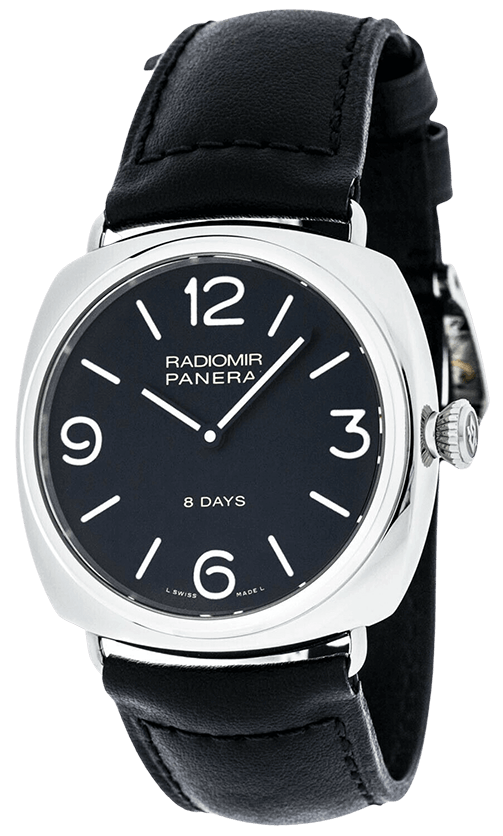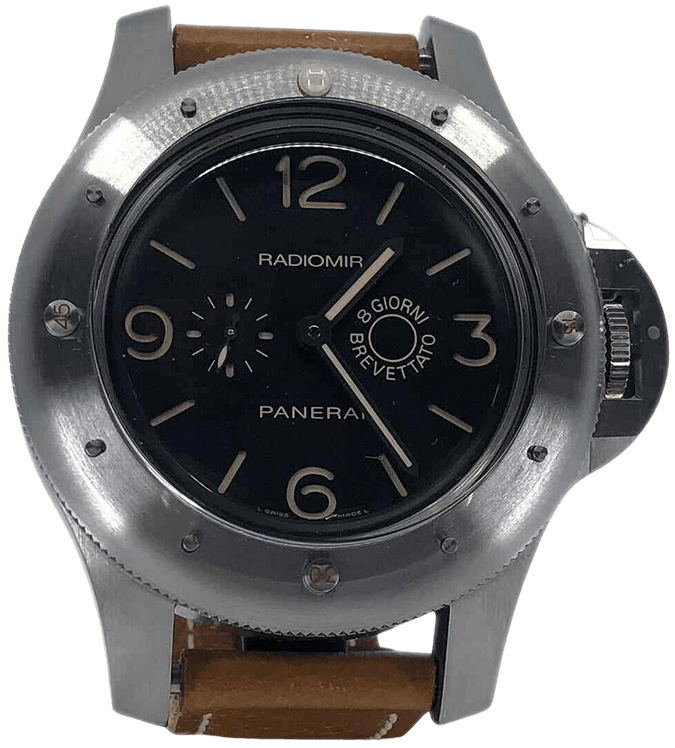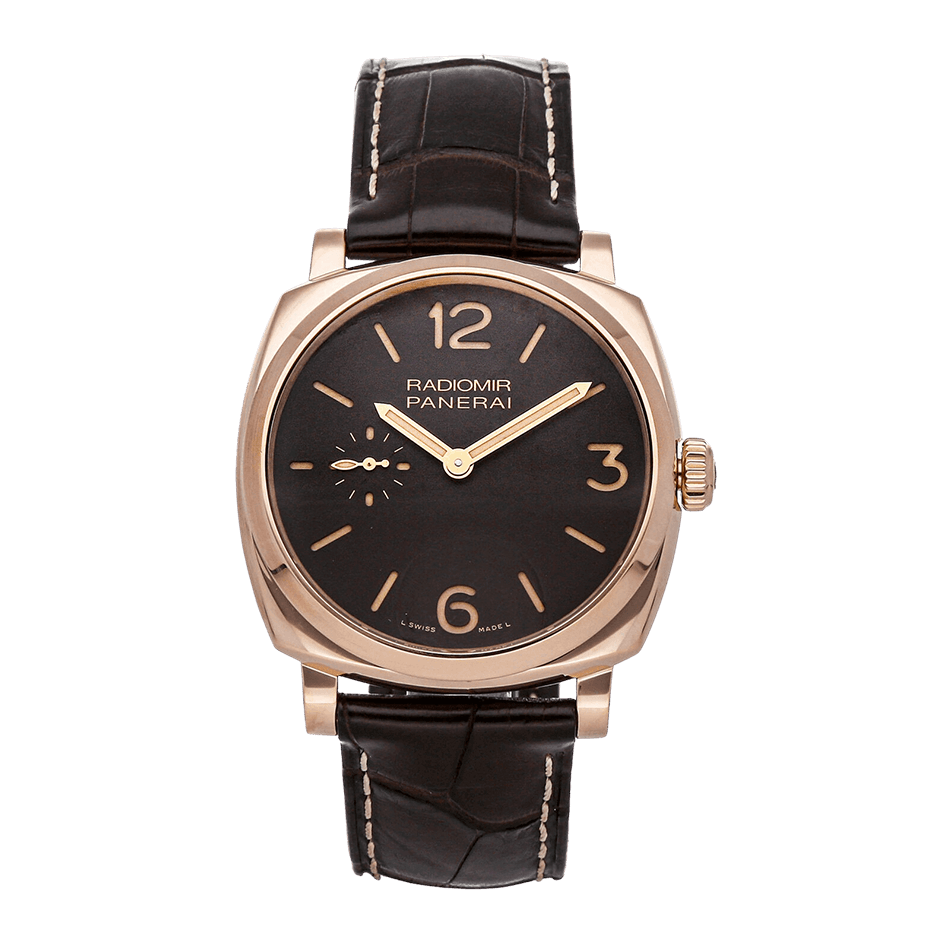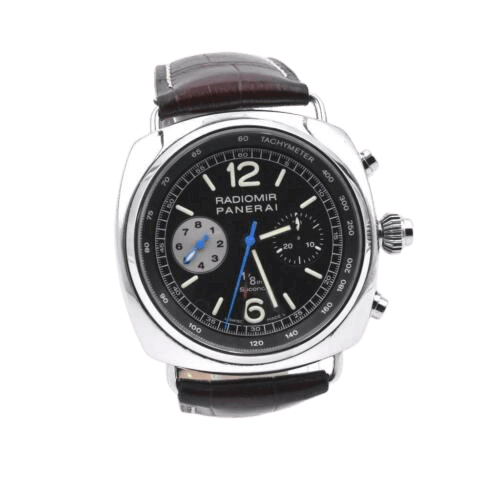Panerai Radiomir Introduction

What is the Difference Between Radiomir and Luminor?
The Radiomir is the original dive watch from Panerai. From its roots as a military watch to its modern luxury styles, the Radiomir is a fascinating and sophisticated timekeeper. It's a watch closely associated with the Panerai Luminor.
The name Radiomir refers to the radium-based luminescent paint that Panerai used to ensure the dial would remain legible even in low-light underwater situations. At the time, the dangerous radioactive properties of radium were not well understood.
The Luminor model was a transition to a tritium-based luminescent paint, which was much safer from a radioactive perspective. Today, both the Radiomir and Luminor models use Super LumiNova luminescent paint, which performs even better than the original radium- and tritium-based luminescent paints.
The Radiomir utilizes wire lugs to keep the strap attached in a secure fashion. The Italian Navy eventually asked Panerai to strengthen the lugs even further, which led to the creation of the Luminor case style. Instead of wire lugs, the Luminor features integrated steel lugs that were cut from the same block of metal as the rest of the case. Both styles look great, but it could be said that the Radiomir style has a more classic design.
Radiomir Case
Styles
Styles
Panerai offers the Radiomir in two distinct case styles. The original version of the Radiomir featured welded wire lugs, which presented the watch with a sleek look that drew the eye to the cushion style case. When the Italian Navy asked Panerai to work on a new case design, Panerai first experimented with modifying the Radiomir lugs, before moving on to the Luminor model.
This transitional model is referred to as the Radiomir 1940, and features the same integrated lugs that are found in the Luminor, but on a Radiomir case. Panerai now offers the Radiomir with both lug styles, which together suit a wide range of tastes and wrist sizes. Certain Radiomir 1940 models also utilize a historically accurate Plexiglass crystal to protect the dial. In addition, Panerai offers the Radiomir in several different case materials, including titanium, rose gold and ceramic.
Titanium

Rose Gold

Ceramic

California Dial
Panerai offers several dial variations in their Radiomir dial, and the California dial is one of the most intriguing versions. It features a mix of Roman and Arabic numerals in a so-called error-proof style. The origins of the California dial are somewhat mysterious. Rolex patented this dial style in 1941, and Panerai claims that their first 1936 prototype Radiomir watches used the California dial. The story is made more complicated by the fact that Rolex manufactured the case and movements for early Panerai watches.
The California name was not popularized until the 1980s, but no one knows exactly how it came about. One theory is that the dial style was especially popular in California. Regardless of the origin of the name, Panerai now uses it to officially describe these dials. They certainly provide a unique look to the Panerai Radiomir, a watch that has a fascinating and complex history.
The Dangers
of Radium
of Radium
The Panerai Radiomir is named after radium, the chemical element that provides its famous glow-in-the-dark attributes. While modern versions of the Panerai Radiomir no longer use the highly dangerous radioactive element in their dials, the original military-specific models did and remain dangerous to handle today. At the time, just before World War II in the 1930s, radium was considered to be a health supplement. Advertisements talked about completely false claims that radium could cure arthritis and prevent wrinkles. Health spas even offered the ability to bathe in radium water, which would leave the bather with a "healthy glow"!
Today, vintage Panerai Radiomir watches should be handled with care, including the use of a Geiger counter. Vintage Radiomirs with radium paint have stopped glowing, as the zinc sulfide reactive agent in the paint has worn out. However, the paint is still radioactive, as radium has a half-life of 1,600 years.
Are Panerai Watches Swiss made?
In a move to secure the future of the brand, Panerai was acquired by the Vendôme Group in 1997. The Vendôme Group is now known as The Richemont Group, one of the world's largest luxury brand conglomerates. After this purchase, Panerai began to relocate its operations to Switzerland. Switzerland offered the benefit of having a large network of component and tool suppliers for the watchmaking industry, which is largely unique in the world.
In 2002, Panerai completed this move and opened their new manufacturing center in Neuchatel, Switzerland. This new location allowed Panerai to bring its planning, research, development and manufacturing all under one roof. At the same time, Panerai retained their world-famous location in Florence, Italy, and now has boutiques in major cities around the world.
Watchmaker's Perspective
The Panerai Radiomir has a complicated and sometimes controversial history, but it is a real history. The Radiomir was built in response to a military need, and contained a number of innovations that went on to become popular in the wider world of horology. One of these less-recognized innovations is the Radiomir's use of Plexiglass instead of a glass crystal. Panerai knew that the Radiomir would be subject to very harsh environments, and likely suffer a number of hard knocks to the case and crystal while in the course of duty. Plexiglass provided a more durable alternative to glass, and provided an element of safety. A direct shock to a glass crystal would shatter the crystal, and flood the dive watch with water, rendering it inoperable. Plexiglass simply doesn't shatter in the same way, but it is more susceptible to surface scratches. Panerai decided that the tradeoff was worthwhile. In the future, more watches would use Plexiglass. The Omega Speedmaster "Moonwatch" was one of the most famous examples. Today, modern Panerai Radiomir watches use sapphire crystals, which are exceptionally durable.



































































